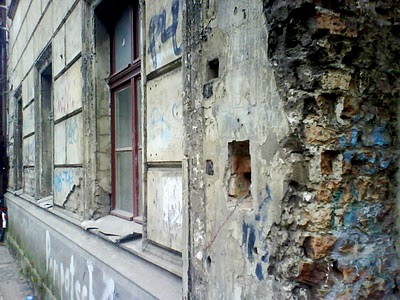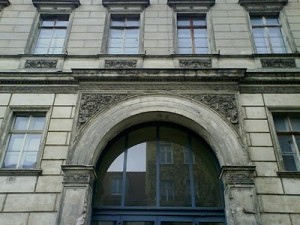Augustraße 14-16
 It is 1933 and Hitler has come to power. You are Jewish and live in Berlin. Do you have the lucidity, cynisicm, clairvoyance or paranoia to leave Germany? The decision of an optimist may have doomed his family to the camps.
It is 1933 and Hitler has come to power. You are Jewish and live in Berlin. Do you have the lucidity, cynisicm, clairvoyance or paranoia to leave Germany? The decision of an optimist may have doomed his family to the camps.
On Auguststraße, in the heart of the old Jewish quarter in Mitte, where luminaries like Moses Mendelssohn first came to Berlin, is a building whose function was largely forgotten between 1945 and the fall of the Wall when it was a school and dormitory.
It was built in 1860 by a private architect, Eduard Knoblauch, on a commission from the Jewish community who were overseeing the completion of the New Synagogue (1866) around the corner on Oranienburgerstraße.
Stand before this Prussian building on Auguststraße and it appears much like others in the classical style in Mitte. What is unusual is the decorated arch, a gesture of wonky grandeur beneath an elegant piano nobile.
Here was the most modern hospital in Germany before the First World War. It was supported through donations from the Jewish community and open to patients of all faiths and incomes. After WW1, when a large Jewish hospital was opened in Wedding, the building took on a new life as a Jewish orphanage called Ahawah, which in Hebrew means ‘love’.
Imagine that you are entrusted with the mission to head an orphanage for Jewish children in Berlin in the years Hitler rose to power. Beata Berger was the protagonist, and would take on an enormous responsibility. She quickly saw that these children had no future in Germany and agitated, between 1934-5, to raise money, organise visas, and evacuate a hundred children to Palestine. She died in 1940, having succeeded in her mission and spared the horrific endgame of the Holocaust.
Come to Augustraße today, with its cafés, art galleries, and tourists pursuing a sanitised version of arty Berlin, and it is easy to pass by this deteriorating facade, behind which so much misery was endured. It is ironic and sad that a building dedicated to the curing of illnesses became a Gestapo detention centre for the old and sick who would be transported to death camps (between 1941-45). The children of Ahawah, those who did not make it to Palestine, had already been murdered.
I do not know, when looking at this facade, scarred by air raids, schapnel, and neglect, to feel encouraged by the efforts of those who have the foresight to save others. Or, rather, should I reflect on the greater number –many of whom had contributed so much to the city’s institutions– who could not leave or who simply decided ‘this is our home, we will stay’.



Fascinating, J. As you know, al-hawa' is also love in Arabic.